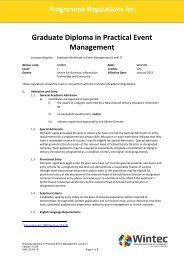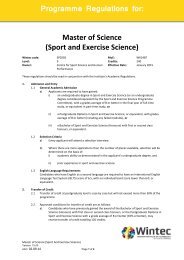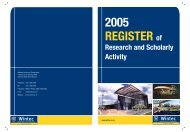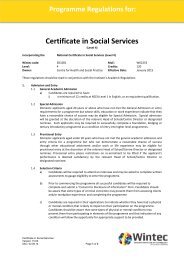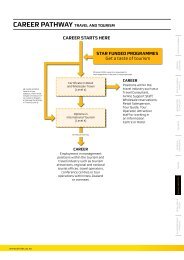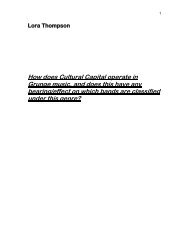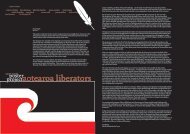Physiological analysis of the metabolic typing diet in professional ...
Physiological analysis of the metabolic typing diet in professional ...
Physiological analysis of the metabolic typing diet in professional ...
Create successful ePaper yourself
Turn your PDF publications into a flip-book with our unique Google optimized e-Paper software.
The <strong>metabolic</strong> data has been used <strong>in</strong> two ways: <strong>the</strong> RQ, which has a value between 0.7 and 1.0 under<br />
normal conditions, represents <strong>the</strong> major fuel burnt at that time, with 0.75-0.85 represent<strong>in</strong>g mixed oxidation<br />
and 0.86 to 1.0 closer to carbohydrate oxidation. All but one <strong>of</strong> <strong>the</strong> athletes <strong>in</strong> this study were classified as<br />
mixed oxidizers, as shown <strong>in</strong> Table 3. This agrees fairly well with <strong>the</strong> questionnaire data. However, <strong>the</strong> rest<strong>in</strong>g<br />
<strong>metabolic</strong> rate test measured for 20 m<strong>in</strong>utes and estimated for a whole day appeared to be quite low <strong>in</strong> all<br />
four <strong>of</strong> <strong>the</strong> five subjects when compared with <strong>the</strong> predicted <strong>metabolic</strong> rate as shown <strong>in</strong> Table 3. This would<br />
categorise four <strong>of</strong> <strong>the</strong> athletes as slow oxidizers and one as fast.<br />
Table 4: Blood glucose read<strong>in</strong>gs at rest, 30 and 75 m<strong>in</strong>utes after 50 grams <strong>of</strong> carbohydrate and correspond<strong>in</strong>g<br />
<strong>metabolic</strong> type <strong>diet</strong> category based on <strong>the</strong> modified glucose challenge.<br />
Subjects Fasted 30 m<strong>in</strong>utes 75 m<strong>in</strong>utes Metabolic Type<br />
1 4.4 6.1 4.3 Extreme Fast<br />
2 4.8 8.3 4.6 Extreme Fast<br />
3 4.9 6.8 5.2 Moderate Fast<br />
4 4.4 7 4.9 Moderate Fast<br />
5 4.8 5.7 4.9 Moderate Fast<br />
F<strong>in</strong>ally a modified glucose challenge test was performed on all subjects with measurements taken at rest, 30<br />
and 75 m<strong>in</strong>utes after consumption <strong>of</strong> 50 grams <strong>of</strong> carbohydrate - <strong>in</strong> this case jelly beans. Based on <strong>the</strong> blood<br />
glucose measurements as shown <strong>in</strong> Table 4, two <strong>of</strong> <strong>the</strong> subjects were categorised as extreme fast and <strong>the</strong><br />
o<strong>the</strong>r three as moderate fast. Moderate fast is quite close to a mixed oxidizer category and <strong>the</strong>refore would<br />
be seen to be close to <strong>the</strong> questionnaire results.<br />
SMNZ Street Address<br />
NZ Sports Academy SI<br />
40 Logan Park Drive<br />
Duned<strong>in</strong><br />
New Zealand<br />
46 NZJSM<br />
DISCUSSION<br />
In <strong>the</strong> past few years <strong>diet</strong>ary regimes written for<br />
<strong>in</strong>dividuals has become popular. For example, recent<br />
research has shown sedentary females display<strong>in</strong>g<br />
signs <strong>of</strong> <strong>the</strong> <strong>metabolic</strong> syndrome may benefit more<br />
from a moderate carbohydrate and higher prote<strong>in</strong><br />
<strong>in</strong>takes than had orig<strong>in</strong>ally been advocated. Diet<br />
plans such as <strong>the</strong> CSIRO total wellbe<strong>in</strong>g <strong>diet</strong> have<br />
risen from such research and suggest that different<br />
people have different <strong>metabolic</strong> rates and require a<br />
<strong>diet</strong> to match this 10 . However, <strong>the</strong> CSIRO wellbe<strong>in</strong>g<br />
<strong>diet</strong> is aimed at sedentary females but is unlikely to<br />
be appropriate for active male pr<strong>of</strong>essional rugby<br />
players. There has been <strong>in</strong>terest from with<strong>in</strong> <strong>the</strong><br />
pr<strong>of</strong>essional rugby teams <strong>in</strong> New Zealand to go<br />
beyond <strong>the</strong> realms <strong>of</strong> traditional sport nutrition to<br />
f<strong>in</strong>d <strong>the</strong> performance edge. This study was designed<br />
as a prelim<strong>in</strong>ary study to determ<strong>in</strong>e whe<strong>the</strong>r <strong>the</strong><br />
MTD warrants fur<strong>the</strong>r <strong>in</strong>vestigation as a basis for<br />
design<strong>in</strong>g nutritional plans for pr<strong>of</strong>essional players.<br />
Modified Glucose Tolerance<br />
Kristal 8<br />
developed a test which he termed <strong>the</strong><br />
“Modified Glucose Tolerance Test” to help determ<strong>in</strong>e<br />
ones <strong>metabolic</strong> type based on how an <strong>in</strong>dividual<br />
oxidises <strong>the</strong> glucose/potassium solution. Kristal 8<br />
reported that a fast oxidiser tended to burn up<br />
glucose too quickly and <strong>the</strong>refore required more<br />
<strong>diet</strong>ary prote<strong>in</strong> and fat to slow down <strong>the</strong> rate <strong>of</strong><br />
glucose combustion. Conversely, slow oxidisers<br />
did not burn up glucose as rapidly and <strong>the</strong>refore<br />
it is proposed <strong>the</strong>y require a higher percentage <strong>of</strong><br />
glucose (and less prote<strong>in</strong> and fats) to create acid-base<br />
balance. Followers <strong>of</strong> <strong>the</strong> <strong>diet</strong> are told to <strong>in</strong>terpret<br />
<strong>the</strong> blood glucose results from <strong>the</strong> modified glucose<br />
tolerance test us<strong>in</strong>g <strong>the</strong> <strong>in</strong>formation provided <strong>in</strong><br />
Table 1. Table 1 assists <strong>in</strong> determ<strong>in</strong><strong>in</strong>g <strong>the</strong> <strong>metabolic</strong><br />
type and also helps categorise an <strong>in</strong>dividual with<strong>in</strong><br />
<strong>the</strong> oxidative system as ei<strong>the</strong>r Extreme, Moderate,<br />
Slight, Very Slight, or Balanced Oxidative.<br />
The modified glucose tolerance test demonstrates<br />
how an <strong>in</strong>dividual metabolises glucose and <strong>the</strong><br />
results from this test suggest that, regardless <strong>of</strong><br />
body type, all subjects <strong>in</strong> this study presented with a<br />
similar tolerance to <strong>the</strong> glucose/potassium solution.<br />
All participants displayed an extreme to moderately<br />
fast oxidative rate which, for three <strong>of</strong> <strong>the</strong> subjects,<br />
agreed quite well with <strong>the</strong> questionnaire rat<strong>in</strong>gs.<br />
Research <strong>in</strong>to sedentary subjects suggests that a<br />
glucose challenge test will result <strong>in</strong> differences <strong>in</strong><br />
blood glucose response between <strong>in</strong>dividuals that<br />
can be <strong>the</strong> result <strong>of</strong> chronic activity levels, obesity<br />
and/or genetic differences. That is, sedentary prediabetic<br />
<strong>in</strong>dividuals tend to show a blunted response<br />
to 50 grams <strong>of</strong> carbohydrate, which has implications<br />
for weight loss and appetite 11,12 . However, <strong>the</strong> group<br />
<strong>of</strong> pr<strong>of</strong>essional rugby players studied appears to<br />
respond similarly to <strong>the</strong> glucose challenge. This is <strong>the</strong><br />
likely outcome for a group <strong>of</strong> elite athletes who are<br />
regularly tra<strong>in</strong><strong>in</strong>g many times a day. Therefore, while<br />
<strong>the</strong> modified glucose challenge may be somewhat<br />
useful <strong>in</strong> a sedentary population, it appears unlikely<br />
to detect differences <strong>in</strong> metabolism <strong>in</strong> a group <strong>of</strong><br />
well-tra<strong>in</strong>ed <strong>in</strong>dividuals.<br />
Rest<strong>in</strong>g Metabolic Rate<br />
The Rest<strong>in</strong>g Metabolic Rate (RMR) test provides a<br />
good estimate <strong>of</strong> what fuel an <strong>in</strong>dividual oxidises<br />
at rest, signified by <strong>the</strong> RQ. The predicted RMR, as<br />
determ<strong>in</strong>ed by a subject’s age, weight, height, and<br />
activity level, is compared to <strong>the</strong> subject’s actual RMR.<br />
If <strong>the</strong> actual RMR is higher than <strong>the</strong>ir predicted RMR<br />
<strong>the</strong>n <strong>the</strong> subject would be classed as fast oxidative.



